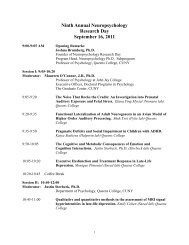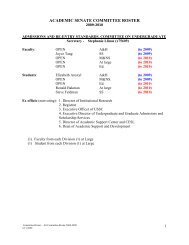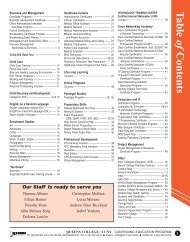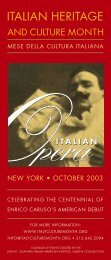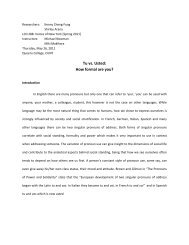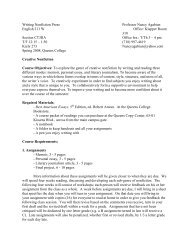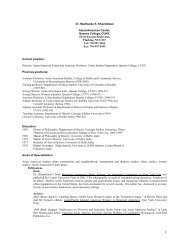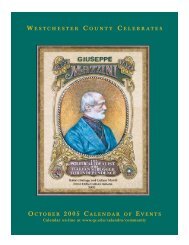How has evolution shaped human behavior? Richard Alexander's ...
How has evolution shaped human behavior? Richard Alexander's ...
How has evolution shaped human behavior? Richard Alexander's ...
You also want an ePaper? Increase the reach of your titles
YUMPU automatically turns print PDFs into web optimized ePapers that Google loves.
Evolution and Human Behavior 26 (2005) 1–9<strong>How</strong> <strong>has</strong> <strong>evolution</strong> <strong>shaped</strong> <strong>human</strong> <strong>behavior</strong>?<strong>Richard</strong> Alexander’s contribution to animportant questionWilliam Irons*Department of Anthropology, Northwestern University, 1810 Hinman Avenue, Evanston,IL 60208-1310, USAInitial receipt 19 July 2004; final revision received 27 August 2004Abstract<strong>Richard</strong> Alexander <strong>has</strong> been a major contributor to the development of theory concerning the<strong>evolution</strong> of <strong>human</strong> sociality. His most important contributions include (1) a theory of the <strong>evolution</strong> ofmorality as a form of indirect reciprocity that aids in intergroup competition, (2) a theory of therelationship between biological <strong>evolution</strong> and culture, (3) an elaboration of Humphrey’s theory of the<strong>human</strong> intellect as a social tool, (4) theories about <strong>human</strong> parental investment and nepotism, and(5) theories about scenario building, consciousness, and <strong>human</strong> communication. He also <strong>has</strong> offered ahypotheses on a large range of other <strong>human</strong> traits. He is a biologist and <strong>has</strong> also made majorcontributions to theories of speciation, communication, eusociality, and social organization innon<strong>human</strong> animals and <strong>has</strong> contributed extensively to the study of a number of specific taxa other thanthe <strong>human</strong> species: crickets, katydids, cicadas, naked mole rats, and horses. His contribution to thestudy of non<strong>human</strong> animals and <strong>evolution</strong>ary theory, in general, are sufficient to earn him a reputationas an outstanding leader in biology without reference to his work on <strong>human</strong>s. The same can be said forhis contribution to the understanding of <strong>human</strong> sociality taken alone.D 2005 Elsevier Inc. All rights reserved.Keywords: <strong>Richard</strong> Alexander; Evolution of <strong>human</strong> sociality; Balance-of-power hypothesis; Indirect reciprocity;Morality; Intelligence; Evolution and culture; Language; Gossip; Parental care; Nepotism* E-mail address: w-irons@northwestern.edu.1090-5138/04/$ – see front matter D 2005 Elsevier Inc. All rights reserved.doi:10.1016/j.evolhumbehav.2004.08.016
W. Irons / Evolution and Human Behavior 26 (2005) 1–9 32. Balance of power, indirect reciprocity, and moralityAlexander’s most significant contribution to the study of the <strong>evolution</strong>ary foundation of<strong>human</strong> <strong>behavior</strong> lies in the area of ground-breaking hypotheses that have served as thefoundation of much of the work that is currently being done on the <strong>evolution</strong> of <strong>human</strong><strong>behavior</strong>. In my opinion, his single most important idea is the balance-of-power hypothesis,which is the core of his 1987 book The Biology of Moral Systems. This idea, or ideas verymuch like it, had been suggested and explored earlier by a number of writers, includingAlexander himself (Alexander, 1979; Alexander & Tinkle, 1981; Bigelow, 1969; Durham,1976; Humphrey, 1976; Keith, 1949; Wilson, 1973, 1975), but he was the first to explore theidea at length and to tie it to an important <strong>human</strong> trait—morality. His reasoning was asfollows. Human beings have an unusually elaborate form of sociality. Social groups of thesize and complex structure of <strong>human</strong> groups are rare in the animal world, and when they doevolve, they are usually based on kinship. There are two broad categories of reasons for the<strong>evolution</strong> of large social groups: larger groups are, in some environments, better at gainingfood (or perhaps some other resource) and larger groups are better, in some environments, atdefending against predators. In the <strong>human</strong> case, the evidence suggests that defense againstpredators is the primary driving force behind the <strong>evolution</strong> of <strong>human</strong> sociality and that thepredators consisted of other <strong>human</strong> groups. Human social groups have a long history ofhostile aggression against other <strong>human</strong> groups (Chagnon, 1974, 1997; Keeley, 1996;Wrangham & Peterson, 1996), and in this kind of direct competition, larger, better-unitedgroups definitely have an advantage. This created a strong selective pressure for the formationof larger social groups and led to a runaway selection for psychological abilities andpropensities that facilitated the formation of larger, better united social groups.Morality is one of these traits. Morality is an important tool for forming larger, moresolidary social groups because it alleviates the problem of within-group conflict. Largersocial groups are more prone to internal conflict, and moral sentiments and principles tendto dampen these internal conflicts. It should be noted at the same time that morality istypically something that <strong>human</strong> beings perceive as relevant to social interaction withinsocial groups. Human beings have a very strong tendency to divide themselves into in- andout-groups, and morality is often not considered relevant to the treatment of members ofout-groups. In fact, the moral thing to do is often to mistreat and even attack and killmembers of other competing social groups. This is what one would expect as a result ofselection for advantages in intergroup competition. Morality <strong>has</strong> a dark side, and Alexander,in all of his writings, never shies away from pointing out the dark sides of various <strong>human</strong>traits, a habit that <strong>has</strong> earned him hostile treatment by defenders of moralizing social scienceand moralizing <strong>human</strong>istic authors. (For example, see Kitcher, 1985. To put Kitcher’s bookand the bDarwin warsQ in perspective, I recommend reading Radcliffe <strong>Richard</strong>s, 2000 andSegerstråle, 2000.)A closely connected idea is that of indirect reciprocity. Alexander proposed that moralsystems are systems of indirect reciprocity. Alexander (1987, p. 93) described indirectreciprocity as ba consequence of direct reciprocity occurring in the presence of interestedaudiences—groups of individuals who continually evaluate the members of their society as
4W. Irons / Evolution and Human Behavior 26 (2005) 1–9possible future interactants from whom they would like to gain more than they lose (thisoutcome, of course, can be mutual).Q In such a social environment, in which one is beingcontinually observed by binterested audiences,Q selection would favor displaying the qualityof being altruistic to other individuals and of being a dependable reciprocator. Alexanderexpanded on this idea by suggesting that moral rules and codes are formulated by a process ofdiscourse and negotiation among the members of a society or, in some cases, among the morepowerful members of a society. In this discourse, different individuals advocate rules that willfavor their own reproductive interests, and, eventually, compromise and somethingapproaching consensus is reached. The fact that a large, well-united group <strong>has</strong> an advantagein intergroup competition provides a confluence of interests among group membersencouraging their reaching a mutually satisfactory set of rules governing within-group<strong>behavior</strong>. He summarized this by saying that moral systems are contractual in character andcited Rawls (1971) as having a similar idea about moral rules and codes. Thus, moralauthority is placed in the collectivity.Many of the ideas developed more thoroughly in the Biology of Moral Systems appearedin earlier publications in shorter form. One of these is this idea that the moral authority thatprovides answers to ought-questions lies in bthe entire collectivity of people willing to thinkon such [moral] problems and to participate in their solutionQ (Darwinism and HumanAffairs, 1979, p. 139). This view allows that what is morally acceptable will vary from onesociety to another and from one historic period to another. It also suggests that the process ofchange in moral rules occurs because of a process of discourse and negotiation among themembers of a social group (or perhaps among the most influential and powerful members).One important aspect of this is that it incorporates the fact of cultural variation and theflexibility of <strong>human</strong> <strong>behavior</strong>.3. Culture and <strong>evolution</strong>Another area where Alexander made a very important contribution is in the question ofhow to incorporate culture into an <strong>evolution</strong>ary understanding of <strong>human</strong> <strong>behavior</strong>.Anthropologists and other social scientists have long argued that culture is unique to <strong>human</strong>beings, and that, because of the way in which it influences <strong>behavior</strong>, patterns of <strong>human</strong><strong>behavior</strong> cannot be understood as adaptive strategies the way that the <strong>behavior</strong>s of otheranimals can (Sahlins, 1976). Chapter two of Darwinism and Human Affairs is one of the bestearly statements of how the presence of culture is completely compatible with the idea that<strong>human</strong> beings, like other organisms, strive to maximize their individual inclusive fitness. (Asimilar argument was made more briefly in Irons, 1979.) They do this by treating culture as apart of their environment and trying as best they can to use and manipulate it to theiradvantage. The issue of how culture fits into a valid <strong>evolution</strong>ary perspective is still undervigorous debate (see, e.g., Boyd & Richerson, 1985; Cronk, 1999; Richerson & Boyd, 2004),but Alexander’s view of culture, as expressed in Darwinism and Human Affairs, is still verymuch alive and a part of the debate. This is the view that the form of culture in any <strong>human</strong>society is completely a result of <strong>human</strong> beings attempting, in each generation, to do the things
W. Irons / Evolution and Human Behavior 26 (2005) 1–9 5which, in ancestral environments, maximized individual inclusive fitness. This view <strong>has</strong>become so widely known that people who advocate it often do not cite Alexander’s writingson the subject (see, e.g., Cronk, 1999).4. Intelligence as a social toolAlexander’s view of <strong>behavior</strong>al flexibility and culture and his view of indirect reciprocityare closely interrelated. Alexander, along with Humphrey (1976), sees <strong>human</strong> <strong>evolution</strong> asinvolving a kind of arms race for intelligence, especially the kind of intelligence that <strong>has</strong> beenlabeled Machiavellian intelligence. Because <strong>human</strong> beings are constantly observing oneanother and sending each other both honest and dishonest messages, there is an advantage tobeing a little quicker to understand the thought of others and to manipulate them to one’sadvantage. Having fixed and inflexible strategies of social <strong>behavior</strong> would leave onevulnerable to exploitation by those who are more flexible. New strategies and still newercounterstrategies for social interaction are the only formula for success in the environments ofever-shifting confluences and conflicts of interest that are characteristic of <strong>human</strong> societies.The idea that the <strong>human</strong> brain is a social tool explains many aspects of <strong>human</strong> <strong>behavior</strong>. Oneof these is the importance of scenario building and its relationship to consciousness. Humanbeings very often explore multiple courses of action before deciding how to behave, andsharing of these scenarios with close allies is an important way of evaluating which one ismost advantageous.5. Parental care and nepotismAnother trait related to the mind-as-social-tool hypothesis is the vast increase in parentalcare in <strong>human</strong>s. Children have a great deal to learn to become competitive adults in <strong>human</strong>social environments, and a long period of learning, in which they are largely protected andcared for by parents, confers an advantage. This appears to have led to some long-term trendsin <strong>human</strong> <strong>evolution</strong>. One of these trends is the expansion of the circle of kin who invest in thenurturance of offspring. Human beings differ sharply from their closest relatives, the greatapes, in the extent of paternal care. They are also unique among all animals in the extent towhich they track more distant relatives—aunts, uncles, nephews, nieces, cousins, grandparents,and grandchildren—and make careful distinctions of closeness and distance(Alexander, 1979, 1987). Furthermore, <strong>human</strong> beings trace wide networks of relatives bymarriage that are not genetically related to themselves but are genetically related to theirchildren. These more distant kin and relatives by marriage are, at times, important sources ofaid to oneself or one’s children.The involvement of <strong>human</strong> males in both direct and indirect child care, combined with theformation of large, intricately, and flexibly cooperating male groups, <strong>has</strong> led to a number ofadditional traits, such as concealed ovulation and social pair bonds between men and womencombined with elaborate mate guarding. Alexander points out that <strong>human</strong>s are unique in
W. Irons / Evolution and Human Behavior 26 (2005) 1–9 7selective force for the <strong>evolution</strong> of <strong>human</strong> linguistic abilities. The form of conversation thatwas most useful for monitoring the <strong>behavior</strong> of other members of one’s group and, hence,knowing whether their <strong>behavior</strong> threatened or aided one’s own interests was gossip. WhatDunbar is saying, in effect, is that gossip was a tool for indirect reciprocity, although he doesnot use the phrase bindirect reciprocity.Q The hypothesis of Dunbar about gossip is interestingand goes completely beyond anything suggested by Alexander. At the same time, it is built onthe balance-of-power hypothesis and the idea of indirect reciprocity. I see it as relevant to thecurrent discussion because it demonstrates the explanatory power of intergroup competitionand indirect reciprocity as a theoretical framework. I also think it is interesting that Alexanderuses his hypothesis of indirect reciprocity to explain morality and Dunbar uses essentially thesame hypothesis to explain gossip. This suggests that gossip and morality serve the samepurpose. On reflection, most of gossip is about the moral failures and accomplishments ofother members of one’s community, and one of the primary ways in which people discuss andeventually negotiate the moral precepts of their society is through gossip. Morality and gossipare indeed closely intertwined.7. Final observations regarding Alexander’s contributionI have only scratched the surface of Alexander’s rich accomplishments in the developmentof theory relevant to <strong>human</strong> <strong>evolution</strong>. In brief, I might note that there are many other aspectsof our species that he <strong>has</strong> addressed and that his discussion of all of these issues is rich incareful thought and always faithful to the assumption that natural selection at the individuallevel <strong>has</strong> been the primary driving force in <strong>human</strong> <strong>evolution</strong>. If future researchers want to seehow far individual-level selection can go in explaining <strong>human</strong> sociality, Alexander <strong>has</strong> giventhem a rich set of hypotheses to guide their work. Other <strong>human</strong> traits to which he <strong>has</strong> givenattention include relative hairlessness in adults, frontal copulation, female orgasm, sexualdimorphism, ecological dominance and its implications for sociality, socially imposedmonogamy, the combination of high paternity confidence and multimale intricatelycooperating social groups, group–group competition as a form of play, the association oflow paternity confidence and an emp<strong>has</strong>is on uterine kinship, and cross-cousin marriage, tomention a few. <strong>How</strong> many of his hypotheses will stand the test of empirical evaluation is yetto be seen, but, whatever future research reveals about <strong>human</strong> <strong>behavior</strong>, he <strong>has</strong> provided avery valuable set of hypotheses that can guide research, and, at present, much of what he <strong>has</strong>suggested <strong>has</strong> been confirmed empirically. His contribution to our understanding of the<strong>evolution</strong> of <strong>human</strong> <strong>behavior</strong> is vast indeed.I should also point out that he <strong>has</strong> continued to study and publish prodigiously onnon<strong>human</strong> animal sociality. He <strong>has</strong>, in fact, expanded his purview beyond the singing insectsand made significant contributions to the discovery and description of eusociality inmammals, especially naked mole rats, the social organization of horses, and the interrelationsof <strong>human</strong>s and horses. I recently saw a copy of his curriculum vitae and it contained threesingle-authored books, one on singing insects and two on <strong>human</strong>s. It contained a coauthoredbook on Australian crickets and a coedited volume on social <strong>behavior</strong> in both non<strong>human</strong> and
8W. Irons / Evolution and Human Behavior 26 (2005) 1–9<strong>human</strong> animals. It further contained 130 scientific articles and book chapters, roughly 40 ofwhich focus primarily on <strong>human</strong> sociality. Of this large body of literature, I have primarilydiscussed his two books on <strong>human</strong> beings, Darwinism and Human Affairs and The Biology ofMoral Systems, and two of his major articles, bThe <strong>evolution</strong> of social <strong>behavior</strong>Q (1974) andb<strong>How</strong> did <strong>human</strong>s evolve? Reflections on the uniquely unique speciesQ (Alexander, 1990).The rest of his publications contain a great deal more.AcknowledgmentsI would like to thank <strong>Richard</strong> Alexander for being a friend and a supportive colleaguesince we first met in 1975 and for providing many personal reflections that helped me inwriting this essay. I also wish to thank him for creating much of the theoretical frameworkthat <strong>has</strong> guided my research and teaching. I would like to thank the editors of Evolution andHuman Behavior for inviting me to write this tribute.ReferencesAlexander, R. D. (1971). The search for an <strong>evolution</strong>ary philosophy of man. Proceedings of the Royal Society ofVictoria, 84, 99–120.Alexander, R. D. (1979). Darwinism and <strong>human</strong> affairs. Seattle, WA7 University of Washington Press.Alexander, R. D. (1986). Ostracism and indirect reciprocity: the reproductive significance of humor. Ethology andSociobiology, 7, 253–270.Alexander, R. D. (1987). The biology of moral systems. New York7 Aldine de Gruyter.Alexander, R. D. (1989). The <strong>evolution</strong>ary significance of the aesthetic sense. LSA Magazine, 12(2), 22–24.Alexander, R. D. (1990). <strong>How</strong> did <strong>human</strong>s evolve? Reflections on the uniquely unique species. University ofMichigan Museum of Zoology, Special Publication, 1, 1–38.Alexander, R. D., & Tinkle, D. W. (Eds.). (1981). Natural selection and social <strong>behavior</strong>: recent research and newtheory. New York7 Chiron Press.Bigelow, R. S. (1969). The dawn warriors: man’s <strong>evolution</strong> toward peace. Boston7 Little Brown.Boyd, R., & Richerson, P. J. (1985). Culture and the <strong>evolution</strong>ary process. Chicago7 University of ChicagoPress.Chagnon, N. A. (1974). Studying the Yanomamö. New York7 Holt, Rinehart, and Winston.Chagnon, N. A. (1997). Yanomamö. New York7 Harcourt Brace College Publishers.Cronk, L. (1999). That complex whole. Boulder, CO7 Westview Press.Dunbar, R. I. M. (1996). Grooming, gossip, and the <strong>evolution</strong> of language. Cambridge, MA7 Harvard UniversityPress.Durham, W. H. (1976). The adaptive significance of cultural <strong>behavior</strong>. Human Ecology, 4, 89–121.Humphrey, N. K. (1976). The social function of intellect. In P. P. G. Bateson, & R. A. Hinde (Eds.), Growingpoints in ethology (pp. 303–321). Cambridge7 Cambridge University Press, 303–321.Irons, W. (1979). Natural selection, adaptation, and <strong>human</strong> social <strong>behavior</strong>. In N. A. Chagnon, & W. Irons(Eds.), Evolutionary biology and <strong>human</strong> social <strong>behavior</strong>: an anthropological perspective (pp. 4–38).Scituate, MA7 Duxbury.Keeley, L. H. (1996). War before civilization (pp. 4–38). New York7 Oxford University Press.Keith, A. (1949). A new theory of <strong>human</strong> <strong>evolution</strong>. New York7 Philosophy Library.
W. Irons / Evolution and Human Behavior 26 (2005) 1–9 9Kitcher, P. (1985). Vaulting ambition. Cambridge7 MIT Press.Radcliffe <strong>Richard</strong>s, J. (2000). Human nature after Darwin: a philosophical introduction. London7 Routledge.Rawls, J. (1971). A theory of justice. Cambridge, MA7 Harvard University Press.Richerson, P. J., & Boyd, R. (2004). Not by genes alone: how culture transformed <strong>human</strong> <strong>evolution</strong>. Chicago7University of Chicago Press.Sahlins, M. (1976). The use and abuse of biology. Ann Arbor, MI7 University of Michigan Press.Segerstr3le, U. (2000). Defenders of the truth: the battle for science in the sociobiology debate and beyond.Oxford7 Oxford University Press.Wilson, O. (1973). The queerness of social <strong>evolution</strong>. Bulletin of the Entomological Society of America,19, 20–22.Wilson, E. O. (1975). Sociobiology: the new synthesis. Cambridge, MA7 Harvard University Press.Wrangham, R., & Peterson, D. (1996). Demonic males: apes and the origin of <strong>human</strong> violence. Boston7Houghton Mifflin.



